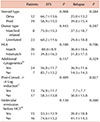1. Bleckmann K, Schrappe M. Advances in therapy for Philadelphia-positive acute lymphoblastic leukaemia of childhood and adolescence. Br J Haematol. 2016; 172:855–869.


2. Aricò M, Valsecchi MG, Camitta B, et al. Outcome of treatment in children with Philadelphia chromosome-positive acute lymphoblastic leukemia. N Engl J Med. 2000; 342:998–1006.


5. Rives S, Estella J, Gómez P, et al. Intermediate dose of imatinib in combination with chemotherapy followed by allogeneic stem cell transplantation improves early outcome in paediatric Philadelphia chromosome-positive acute lymphoblastic leukaemia (ALL): results of the Spanish Cooperative Group SHOP studies ALL-94, ALL-99 and ALL-2005. Br J Haematol. 2011; 154:600–611.


6. Biondi A, Schrappe M, De Lorenzo P, et al. Imatinib after induction for treatment of children and adolescents with Philadelphia-chromosome-positive acute lymphoblastic leukaemia (EsPhALL): a randomised, open-label, intergroup study. Lancet Oncol. 2012; 13:936–945.


9. Lee JW, Kim SK, Jang PS, et al. Treatment of children with acute lymphoblastic leukemia with risk group based intensification and omission of cranial irradiation: a Korean study of 295 patients. Pediatr Blood Cancer. 2016; 63:1966–1973.


10. Ottmann OG, Wassmann B, Pfeifer H, et al. Imatinib compared with chemotherapy as front-line treatment of elderly patients with Philadelphia chromosome-positive acute lymphoblastic leukemia (Ph+ALL). Cancer. 2007; 109:2068–2076.


11. Lee S, Kim YJ, Chung NG, et al. The extent of minimal residual disease reduction after the first 4-week imatinib therapy determines outcome of allogeneic stem cell transplantation in adults with Philadelphia chromosome-positive acute lymphoblastic leukemia. Cancer. 2009; 115:561–570.

12. Zawitkowska J, Lejman M, Zaucha-Prażmo A, et al. Clinical characteristics and analysis of treatment result in children with Ph-positive acute lymphoblastic leukaemia in Poland between 2005 and 2017. Eur J Haematol. 2018; 101:542–548.


13. Roy A, Bradburn M, Moorman AV, et al. Early response to induction is predictive of survival in childhood Philadelphia chromosome positive acute lymphoblastic leukaemia: results of the Medical Research Council ALL 97 trial. Br J Haematol. 2005; 129:35–44.


15. Talano JM, Casper JT, Camitta BM, et al. Alternative donor bone marrow transplant for children with Philadelphia chromosome ALL. Bone Marrow Transplant. 2006; 37:135–141.


16. Espérou H, Boiron JM, Cayuela JM, et al. A potential graft-versus-leukemia effect after allogeneic hematopoietic stem cell transplantation for patients with Philadelphia chromosome-positive acute lymphoblastic leukemia: results from the French Bone Marrow Transplantation Society. Bone Marrow Transplant. 2003; 31:909–918.


19. Slayton WB, Schultz KR, Kairalla JA, et al. Dasatinib plus intensive chemotherapy in children, adolescents, and young adults with Philadelphia chromosome-positive acute lymphoblastic leukemia: results of Children's Oncology Group trial AALL0622. J Clin Oncol. 2018; 36:2306–2314.

20. Yamada K, Yasui M, Kondo O, et al. Feasibility of reduced-intensity allogeneic stem cell transplantation with imatinib in children with philadelphia chromosome-positive acute lymphoblastic leukemia. Pediatr Blood Cancer. 2013; 60:E60–E62.







 PDF
PDF ePub
ePub Citation
Citation Print
Print





 XML Download
XML Download